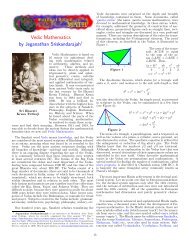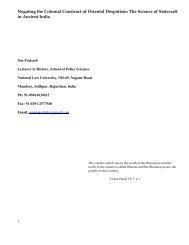The Dhaarmik Traditions - Indic Studies Foundation
The Dhaarmik Traditions - Indic Studies Foundation
The Dhaarmik Traditions - Indic Studies Foundation
You also want an ePaper? Increase the reach of your titles
YUMPU automatically turns print PDFs into web optimized ePapers that Google loves.
30 Brahmi script<br />
ॄःिम<br />
which has a perfectly good name namely Sanatana Dharma. To use the word Rabbi-ism<br />
to describe the faith taught in Synagogues simp<br />
Brahmi is a "syllabic alphabet", meaning that each sign can be either a simple consonant<br />
or a syllable with the consonant and the inherent vowel /a/. Other syllabic alphabets<br />
outside of South Asia include Old Persian and Meroïtic. However, unlike these two<br />
system, Brahmi (and all subsequent Brahmi-derived scripts) indicates the same<br />
consonant with a different vowel by drawing extra strokes, called matras, attached to the<br />
character. Ligatures are used to indicate consonant clusters. <strong>The</strong> Brahmi script was first<br />
deciphered by James Princep although I find it difficult to believe that they could<br />
not find a single Indian who was capable of deciphering the Brahmi script<br />
31 Caste Derived from Portuguese Casta, Caste has a meaning quite distinct from Varna which<br />
has been accepted as being part of the tradition. Caste according to the Portuguese<br />
means a race or a breed. Varna makes no such distinction and to ascribe racial<br />
motivations for a system based on division of labor depending on individual inclinations<br />
and which is a meritocracy to boot, is totally unconscionable, but that is exactly what the<br />
colonial power did with great success . <strong>The</strong> Sanatana Dharma makes no apologies for<br />
being a meritocracy based on competency and character and it is only after the advent of<br />
colonial rule that it took on the character of a racial and ethnic division based on birth. It<br />
is a tribute to the tenacity and persistence of the British that their viewpoint has<br />
prevailed and has been internalized by the <strong>Indic</strong> population for the most part. Yet it<br />
behooves those of us who know better to keep reminding everybody that the colonial<br />
viewpoint reflects a conjured up reality that has no relation to a core value nor is it<br />
derived from core beliefs held since antiquity. see also Varnashrama dharma.<br />
32 Celestial<br />
(Equatorial)Coord<br />
inate System<br />
the most commonly used astronomical coordinate system for indicating the positions of<br />
stars or other celestial objects on the celestial sphere . <strong>The</strong> celestial sphere is an<br />
imaginary sphere with the observer at its center. It represents the entire sky; all celestial<br />
objects other than the earth are imagined as being located on its inside surface. If the<br />
earth's axis is extended, the points where it intersects the celestial sphere are called the<br />
celestial poles; the north celestial pole is directly above the earth's North Pole, and the<br />
south celestial pole directly above the earth's South Pole. <strong>The</strong> great circle on the<br />
celestial sphere halfway between the celestial poles is called the celestial equator; it can<br />
be thought of as the earth's equator projected onto the celestial sphere. It divides the<br />
celestial sphere into the northern and southern skies. An important reference point on<br />
the celestial equator is the vernal equinox, the point at which the sun crosses the<br />
celestial equator in March. To designate the position of a star, the astronomer considers<br />
an imaginary great circle passing through the celestial poles and through the star in<br />
question. This is the star's hour circle, analogous to a meridian of longitude on earth.<br />
<strong>The</strong> astronomer then measures the angle between the angle between the vernal equinox










